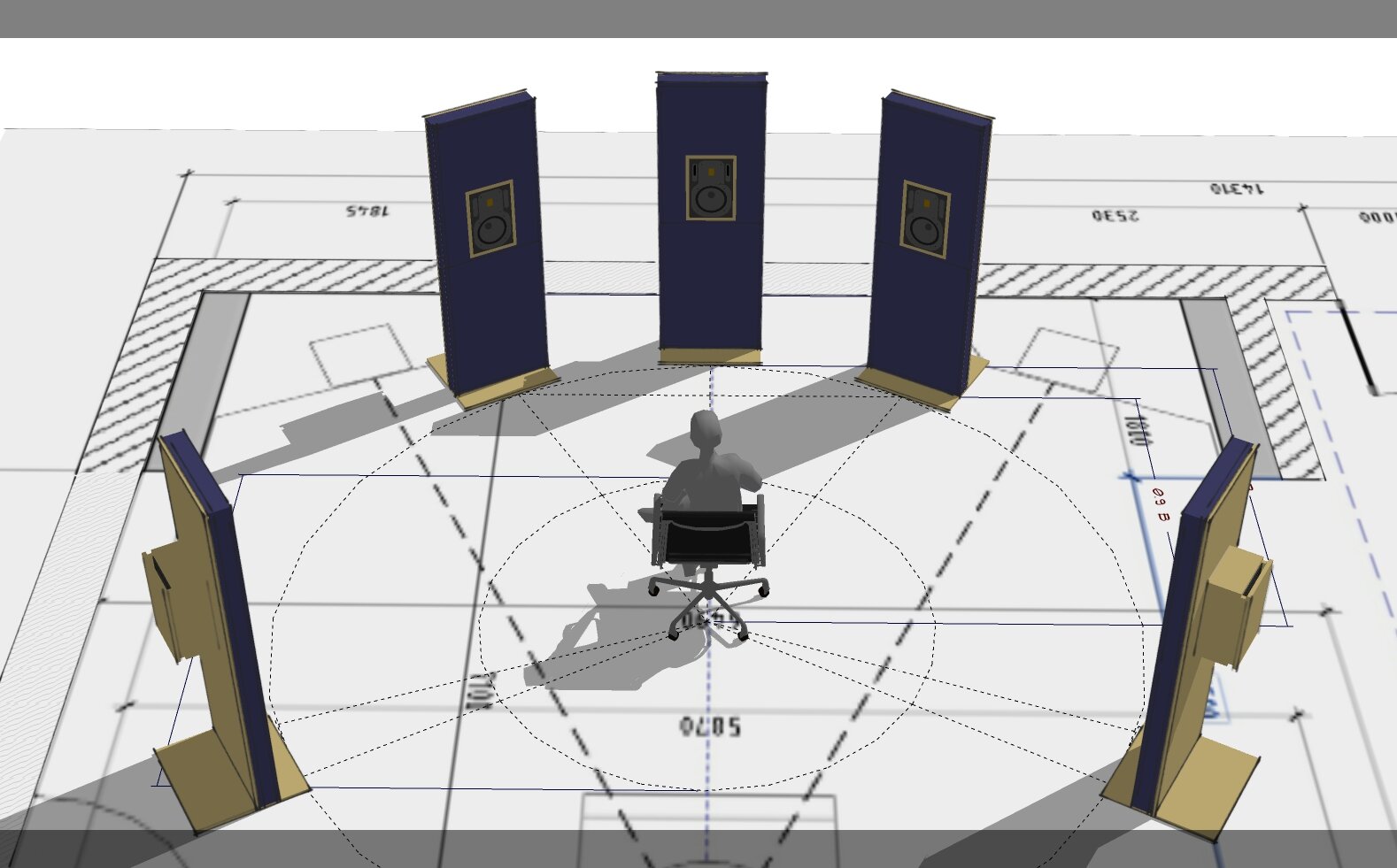-
Posts
2,174 -
Joined
-
Last visited
Everything posted by Glenn Stanton
-
i keep a printed cheat sheet of my buss/track color scheme (small squares with color, RGB#, name of buss). i only have about 30 busses so the groups of them are similar that if my overall template doesn't solve it, i can create a new custom version. although i tend to just use the main templates and trim out what i don't need rather than try to create new versions with track templates (and hopefully someday buss templates!)
-
yeah! then you get the best sound from your 8-bit crusher distortion analog-defect reproduction VSTs! ?
-

Why does Velocity not change the Volume below a certain threshold?
Glenn Stanton replied to Mintaka's question in Q&A
triangle or square wave setting on the synth oscillator(s). sine waves can be hard to hear so the triangle and square wave harmonics will likely be more noticable with lower volume levels... -
my first thought would be the power rectifier tube is fritzing, or the power supply caps are on the way out. doubtful it's the transformer. one option would be to swap out the four (4) tubes for a new set. if you'd don't have electronics repair skills - then take it to a proper shop for repair because changing out components can make things worse if not done correct - product choice and installation etc.
-
it's not the format, it's the option of players on the iphone. if you connect your iphone to your PC, you can directly copy files between them (with the correct drivers) and then install another player which can access those files and play them. otherwise bow in obedience to Apple... ?
-

Why does Velocity not change the Volume below a certain threshold?
Glenn Stanton replied to Mintaka's question in Q&A
maybe create a MIDI clip with notes at each velocity - 1, 5 ,10, 15, 20, 30, 40, 50, etc. if it's a sample based VSTi, it's likely a limit of the sample scaling used, if it's synthesized, maybe some velocity range is imposed to create "realism". perhaps a pure synth set to square or triangle tone would show/sound correctly. -
just to summarize - we're asking about the 64-bit engine - on or off - with regards to how it impacts the rendering of 1) the mixing process, 2) the export out file? maybe @Noel Borthwick can clarify but my understanding is the 64-bit engine processes using 64-bits versus 32-bits in-CPU/in-memory and then depending on your project word size, would store the results by either truncate? or dither? or as @Milton Sica notes - we don't really know what's going on ?
-
it's likely that few people would notice single vs double float processing - i believe in the old forum someone had done some tests with reverb tails tapering more nicely on the double float but it was also specifically testing for it versus what it would be in normal material. since the 64-bit option has been there in SONAR and CbB, i always have it checked. i'm perfectly comfortable using 64-bit processing ?. i just don't use any type of float when processing overnight fed fund currency swaps ? as a note, i generally export either 48K or 44.1K @ 24-bit, no dither WAV. subsequent processing via Ozone 9 which may or may not use double float to render 44.1K 16-bit WAV and MP3.
-
i'm thinking the #2-3 is akin to "bounce to track" effect where the (apparently temporary nature of the gain control) is effecting the level. my guess - the soft synth output is being written to a temp memory queue or temp file while recording it and so its acting like a clip input, it has that level adjustment, but once done, the proper clip file is written, it's written as unity gain as noted. so when recording it from a patch point, which is receiving the gain variations, it does actually record that. my guess is we need an updated flow diagram ? and/or perhaps letting the gain level work on inbound audio regardless of source... (which is likely what the majority of folks would expect).
-
as a note: the original joking around by the Bakers (per Noel and some others) was calling it WASABI... it may have been an internal name by Microsoft as well...
-
yes, not surprising [cough. cough] competition with [cough, cough] paid products is [cough, cough] heating up... ?
-
dealing with intricacies of MIDI often require some details... the OP seemed happy with the original response - use automation. now they're at the point of finding the optimal or alternative MIDI CC which do this best...
-

VoS - Variety of Sound 64 bit plugins now available
Glenn Stanton replied to TracingArcs's topic in Deals
oh, did any one notice the VoS plugins are (being) updated to 64-bit? a minor issue to download. a lifetime to enjoy. i love the baxter EQ and density ones! -
since when do you have 10 seconds? ?
-
i guess the essential or assistant versions support poly-midi conversion but not the actual poly editing. that's good to know. one trick is to copy the part to be converted, into a new clip, and cut the LF and HF so you get mainly dull notes without rumble and squeaks (unless you need the harmonics which may need more HF to properly "appear as notes"). then commit the EQ to the clip. then drag to midi track or create a region fx. this generally helps the algorithm find the notes better which seems to create cleaner midi.
-
while you're trying it... yes, unless i'm really sloppy, the conversion works quite well and editing the individual notes - pitch, timing, noises, etc all work as expected. i have the editor version but presumably the studio version (multi track polyphonic vs single track polyphonic)
-
i use the Melodyne get MIDI from guitar parts for adding bass, piano, organ, pads, solos, etc especially where its quicker to just lay down parts i know will be used for something else while i have my guitar in hand. because it's sourced from the guitar, keyboard parts will be different than if i played them on the keyboard. and if i use a keyboard to drive a guitar instrument VST (e.g. Strum GS-2 or the Kontakt Session Guitarist), those parts also have differences you don't normally get from a guitar performance. so like anything, it depends on the effect you're going for...
-
yeah, the "take" lanes are all kept in a single clip and simply referenced... which makes any edits outside of the UI tricky...
-

SI Drums adjust erratically to Gain knob
Glenn Stanton replied to Dave G's topic in Instruments & Effects
are the velocities set to a given level? the SD kits can have varying volume levels available. so if you set the velocity to 100 (as an example) does the volume still appear problematic? -

ProChannel Concrete Limiter Missing
Glenn Stanton replied to Tay Zonday's topic in Cakewalk by BandLab
if you're account is problematic - reach out to support@cakewalk.com to get them to reactivate your account or reset your password. i though concrete limiter and a few other products were not dependent on the CW version. -
+1 to using the directory junction approach. my stuff is on the D:/ drive but the directory junctions on the C:/ drive make the app think its running on C:/ and all new installations just do their thing. and as i discover new locations on the C:/ drive which contain "stuff" which i don't want there, i move it and create a new junction to match the old folder and viola! as a note: dump a list of your directories periodically to a text file so you can re-create the junctions should you decide to wipe the drive for an OS refresh or replace it with a larger one later.
-
it sounds like @RexRed has all his "tracks" feeding a set of "mix busses" that outputs to a "master" buss (for monitoring) from which ultimately a WAV file is rendered. not a problem unless you're trying to use all those effects chained across the tracks and busses. at that point you're at the mercy of the slowest effect being used. for example, if all my effects have a 5ms latency, but i use a reverb with 30ms latency, then ALL routes will be delayed as necessary to accommodate the 30ms. so where you put that reverb will have more or less impact on synchronization of tracks. if it's on a single track - viola! all tracks will be delayed. if you put it on your master buss, then all tracks will sync to the lowest effect latency, but all will be delayed at the master buss. so then turning on or off the master buss reverb (as an example) will change not only the sound (the reverb is being used presumably because you want reverb) but the overall latency of the system will drop. you could use the PDC button to turn off the latency compensation but there are additional side effects from that. best bet - turn off all the stuff you absolutely don't need while tracking, including muting tracks that aren't needed while tracking. i have something similar for workflow in my templates except i turn off all my effects when tracking, and if later in the mix i need to add or significantly change something, i disable the effects to (re)track something and the turn it back on to continue the mix. once far enough along on the mix, the master buss limiter is kicked on to simulate the master levels i'll do in Ozone later. this way the mix is balanced and will pretty much be how i expect it when i apply the final bits. i use low latency settings for recording, and high latency for mixing. high latency recording of soft-synths once the performance is completed in MIDI. freezing to lock in if i think i'll be doing more performances later. archive all non-used synths and effect. WASAPI is what i'm using with my built-in sound card, or the ASIO specific for my larger IO units.
-

Folderwise Instrument Playing and Recording
Glenn Stanton replied to Indrajeet Raval's question in Q&A
actually most Kontakt "instruments" (not libraries, those have to be registered, free or not) can be used in Kontakt player HOWEVER they can be run in demo mode which means they will cut out after 10 mins (or so). took me a while to figure this out, just as i was getting ready to finally record something, Kontakt would produce no output until i restarted it... -
uninstall it and reinstall it from your original installation files. rescan the plugins. if you need to do some activation steps - i'd run it as standalone. also, that would be a good time to set up the paths for the transfers and separation folders - i put mine in their own folders away from the backup paths to avoid getting thousands of temporary audio snippets backing up...




